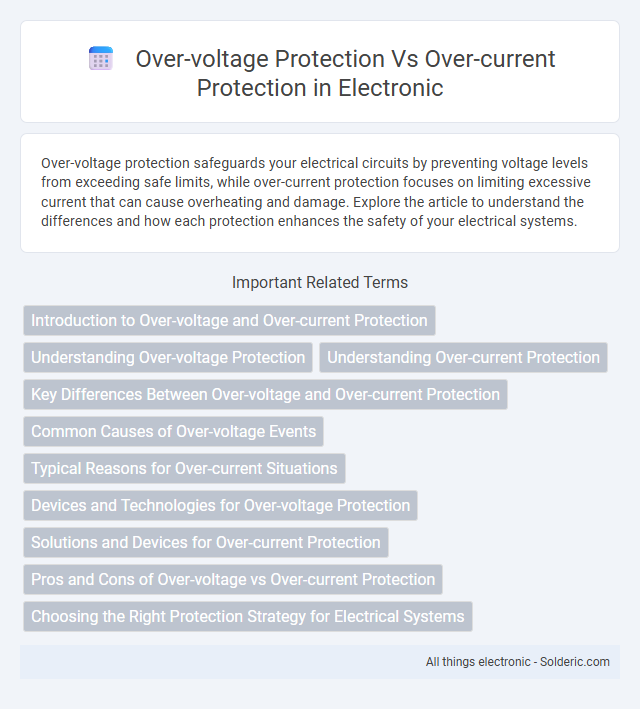Over-voltage protection safeguards your electrical circuits by preventing voltage levels from exceeding safe limits, while over-current protection focuses on limiting excessive current that can cause overheating and damage. Explore the article to understand the differences and how each protection enhances the safety of your electrical systems.
Comparison Table
| Feature | Over-Voltage Protection | Over-Current Protection |
|---|---|---|
| Definition | Prevents voltage from exceeding safe limits in circuits. | Prevents current from exceeding the rated level in circuits. |
| Primary Purpose | Protects devices from voltage spikes and surges. | Protects devices from excessive current and short circuits. |
| Common Devices | Voltage clamping devices, Zener diodes, MOVs (Metal Oxide Varistors). | Fuses, circuit breakers, PTC thermistors. |
| Protection Mechanism | Limits or clamps high voltage to safe levels instantly. | Interrupts or limits current flow to prevent damage. |
| Typical Applications | Power supplies, lightning protection, surge suppressors. | Electrical panels, motor controls, battery circuits. |
| Response Time | Usually very fast (nanoseconds to microseconds). | Varies; can be fast (circuit breakers) or slow (thermal fuses). |
| Failure Mode | May short circuit or clamp voltage, potentially degrading over time. | Typically open circuit, requiring replacement or reset. |
Introduction to Over-voltage and Over-current Protection
Over-voltage protection safeguards electrical devices from voltage spikes exceeding the maximum rated voltage, preventing insulation damage and component failure. Over-current protection limits excessive current flow caused by short circuits or overloads, protecting circuits from overheating and potential fire hazards. Both protection mechanisms are critical for maintaining the safety and reliability of electrical systems in residential, commercial, and industrial applications.
Understanding Over-voltage Protection
Over-voltage protection safeguards electrical devices by preventing voltage levels from exceeding safe limits, reducing the risk of damage caused by power surges or lightning strikes. This protection uses components like voltage clamping devices, surge protectors, and voltage regulators to maintain stability within the electrical system. Ensuring your equipment has proper over-voltage protection prolongs its lifespan and maintains reliable performance under fluctuating power conditions.
Understanding Over-current Protection
Over-current protection safeguards electrical circuits by detecting excessive current flow that can cause overheating and damage. Devices like fuses, circuit breakers, and current sensors interrupt the current to prevent equipment failure or fire hazards. Understanding over-current protection helps you maintain system reliability and ensure safety in electrical installations.
Key Differences Between Over-voltage and Over-current Protection
Over-voltage protection safeguards your electrical systems by preventing voltage levels from exceeding safe thresholds, protecting components from damage due to excess voltage. Over-current protection, on the other hand, focuses on limiting the current flow to prevent overheating and potential fire hazards caused by excessive current. These protections differ primarily in their trigger conditions--voltage spikes versus current surges--making each essential for maintaining system reliability and safety.
Common Causes of Over-voltage Events
Over-voltage events commonly result from lightning strikes, sudden power surges, or switching operations within electrical systems. Faulty equipment or insulation breakdown can also trigger unexpected voltage spikes, leading to potential damage. Effective over-voltage protection devices like surge protectors and voltage clamping components prevent equipment failure by rapidly responding to these transient voltage increases.
Typical Reasons for Over-current Situations
Typical reasons for over-current situations include short circuits, ground faults, and overload conditions caused by excessive load demand or equipment malfunction. Over-current protection devices detect these abnormal current flows to prevent damage to electrical components and reduce fire hazards. Proper sizing and coordination of circuit breakers and fuses ensure timely interruption of excessive currents, maintaining system safety and reliability.
Devices and Technologies for Over-voltage Protection
Devices and technologies for over-voltage protection primarily include surge protectors, voltage clamping components like metal oxide varistors (MOVs), and transient voltage suppression diodes (TVS). These devices safeguard electronic systems by diverting or absorbing excess voltage spikes that can damage sensitive components. Your electronic equipment's longevity and reliability depend significantly on the correct implementation of these over-voltage protection technologies.
Solutions and Devices for Over-current Protection
Over-current protection solutions primarily include circuit breakers, fuses, and current limiters designed to interrupt excessive current flow and prevent damage to electrical equipment. Electronic devices such as solid-state relays and digital over-current relays provide precise current monitoring and fast response times to safeguard circuits from overloads and short circuits. Advanced protection systems integrate sensors and microcontrollers for real-time current analysis, enabling adaptive protection strategies in power distribution and industrial applications.
Pros and Cons of Over-voltage vs Over-current Protection
Over-voltage protection safeguards your electrical devices from voltage spikes by disconnecting or clamping excessive voltage, preventing damage and enhancing equipment longevity, but it may trigger unnecessary shutdowns during transient surges. Over-current protection limits the current flowing through circuits, protecting against short circuits and overloads that cause overheating and potential fire hazards, yet it may not respond to voltage anomalies that can also harm your system. Choosing between over-voltage and over-current protection depends on your specific needs, with over-voltage offering strong defense against voltage surges, while over-current provides crucial safety against excessive current flow.
Choosing the Right Protection Strategy for Electrical Systems
Choosing the right protection strategy for electrical systems involves understanding the distinct roles of over-voltage protection and over-current protection. Over-voltage protection safeguards your equipment from voltage spikes that can cause insulation breakdown and component damage, while over-current protection prevents excessive current flow that can lead to overheating and circuit failure. Implementing a combined approach tailored to your system's load requirements and environmental conditions ensures optimal safety and longevity.
Over-voltage protection vs Over-current protection Infographic

 solderic.com
solderic.com